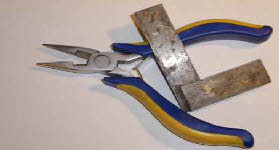


Current drawn is quite high for these magnets so a large enough transformer is required to deliver the required current without overheating. There shouldn’t be any need to have the magnet switched on for more than a minute at the very most, and switching should be via a simple push switch, so that the power to the magnet cannot be accidentally left on for a long period - which will probably damage the coil. The transformer should be separate from other power supplies (ie controllers) otherwise the output voltage may well drop when the electromagnet is switched on, causing the loco to slow or even stop (as I discovered...........).
Sometime ago I bought an electromagnet from Wizard Models (MSE) with the intention of experimenting with it on Brighton Road. Unfortunately the core of the magnet only protrudes 13 mm above the base plate. The total track-base thickness for Brighton Road is about 25 mm (plywood plus camping mat), so the core is nowhere near long enough. Plumpton on the other hand has a 9mm ply top plus 3mm cork, so the 13 mm long core is not a problem.
The instructions say that the magnets are designed to work with 6-12V DC. I tried 6V DC (using a bridge rectifier with the 5V AC supply), but this did nothing at all. I then tried the the 21V DC supply with various power resistors, progressively reducing the resistance until I got to about 12V. This proved rather difficult, since these magnets have very low resistance, and hence draw a high current. At a voltage of about 12V these magnets seem to draw about 2A and since my transformer is not able to deliver 2A, the voltage drops very rapidly and everything gets rather hot. I finally decided to try the 15V AC supply using a power diode to give half-wave rectification. In theory this should deliver about 7.5V average, well within the capacity of the coil. This proved very successful on all fronts - the magnets successfully and reliably uncouple locos (which seem to give problems because of the short fixed nature of the coupling), and the average current drawn is only about 0.5A - well within the capability of my transformer, and the coil itself. The main point here is that although the average voltage and current (and hence wattage) are fairly low, the peak voltage should be about 21V (momentarily) and this is enough to uncouple the most stubborn of couplings.
The only downside is that the AJ’s ‘chatter’ because of the half-wave power, and make a bit of a noise. I can hear this in my workroom, but I doubt that it could be heard at all in an exhibition environment. With a bit more experimentation, I found that a 4R7 power resistor in series with the coil reduces the voltage and current drawn a bit further, (and hence makes the uncoupling a little quieter), but doesn’t materially affect the reliability of the uncoupling.
What to do first
Converting existing stock to AJ’s (especially if you have a lot of stock) is quite a daunting prospect. There are many ways it can be done - this is how I did it:
- lots of practice making couplings and fitting to a few trial wagons
- a lot of experimentation with electromagnets as described above
- ends of some passenger trains, tail traffic, loose vehicles etc and associated locos
- rakes of wagons (2, 3 or 4 wagons in each rake) with AJ’s on each end of the rake
- a few goods engines
- ends of fixed rakes of freight trains
- remainder of goods engines
- progressively break up each rake of wagons into smaller rakes, and finally individual wagons
- remainder of coaching stock (just the ends of the trains)
- remaining locos
Sometime ago I bought an electromagnet from Wizard Models (MSE) with the intention of experimenting with it on Brighton Road. Unfortunately the core of the magnet only protrudes 13 mm above the base plate. The total track-
The instructions say that the magnets are designed to work with 6-
The only downside is that the AJ’s ‘chatter’ because of the half-
What to do first
Converting existing stock to AJ’s (especially if you have a lot of stock) is quite a daunting prospect. There are many ways it can be done -